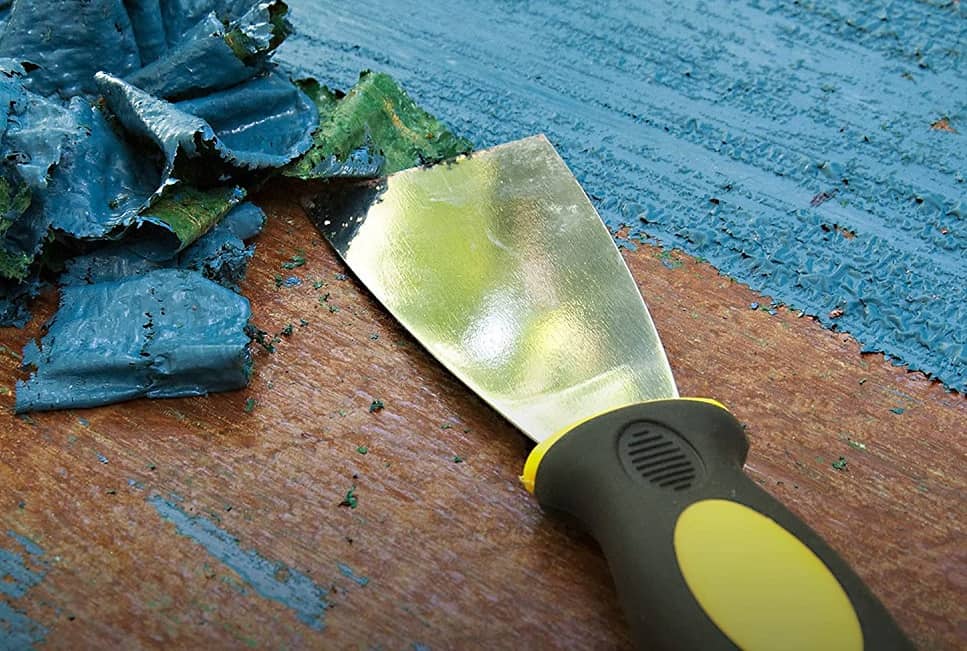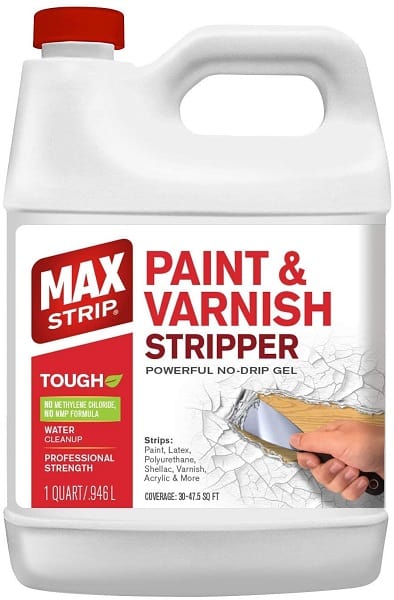- How to Find the Best Ladders: Top 5 Must Have Ladders - June 9, 2021
- How to Find the Best Ceiling Paint - December 24, 2020
- Full Guide to the Best Chisels for Woodworking - December 23, 2020
Stripping paint is sometimes an arduous, time-consuming task. But having the right paint stripper on hand can make the process much easier.
Whether you’re looking to refinish your home’s surfaces, customize a new furniture item to perfectly suit your space, or spruce up a furniture item with fresh paint, using the right paint stripper will wipe the slate clean so you can do the job properly.
While it’s often a demanding job, getting rid of the layers of stains and paint that have accumulated over time can work wonders on your old furniture, leaving it restored and rejuvenated.
In this guide on how to find the best paint stripper, we’ll take a look at the best paint strippers available on the market, as well as what you should consider before buying the right paint stripper.
5 Best Paint Strippers
Best Value for Money: MAX Strip Paint and Varnish Stripper
MAX Strip Paint and Varnish Stripper is a mid-range paint stripper that comes at an affordable price. It works just as effectively as strippers with a bigger price tag.
It works effectively on various materials, helping you strip thick paint without destroying the surface. However, it’s not suitable for plastic material since chemicals can destroy plastic.
This product is particularly odorless, and its ingredients aren’t harmful to the skin as well. When you use MAX Strip Paint and Varnish Stripper, you can rest easy knowing that it’s quite safe for your health.
Since it releases no toxic fumes, you don’t require ventilation to use it. Moreover, this product is very effective for indoor use thanks to its special features. It’s also the best paint remover for both wood and metal.
One thing to note about MAX Strip Paint and Varnish Stripper is that despite being marketed as a gel, its texture is fairly thin and dilute.
That means it’s runny and tends to flow to another place when you’re using it. For this reason, you should pay extra attention and be more careful when using this paint stripper.
Best for Various Materials: Motsenbocker’s Lift Off Latex Paint Stripper Spray
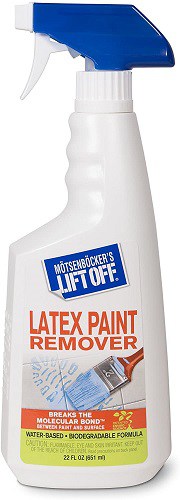
This paint stripper is manufactured in the U.S., so users will appreciate its quality. It’s specially made and works brilliantly on Latex paints. Moreover, it quickly removes stencil and acrylic paints.
The most valuable aspect of this product is its versatility. It can be used on many surfaces, including brick, fiberglass, carpet, and so on. It’s also flexible enough to be spread with a roller, sprayer, or brush.
Motsenbocker’s Lift Off Latex Stripper Spray has a surprisingly quick-acting time. On canvas material, for instance, you just need around 30-60 minutes to remove the paint.
Despite its brilliant features, you’ll need to apply some force and take a bit of time to scrape off all the paint.
Healthiest Choice: Dumond Chemicals Smart Strip 3233 Advanced Paint Stripper
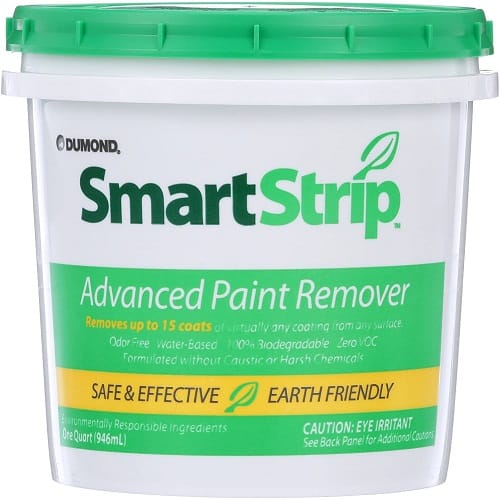
When stripping paint, many users fear that certain substances in paint strippers are harmful to health when touched, especially the awful chemical scent.
However, we think that Smart Strip 3233 Advanced Paint Stripper from Dumond Chemicals is a healthy choice and you’ll feel completely safe when using it.
This outstanding paint stripper is biodegradable. Since its ingredients come in standard dosages, using or touching it won’t hurt your skin.
Besides, the product is odorless, which everyone will appreciate. Of course, no one likes the strong odor of paint strippers.
According to Dumond Chemicals, this paint remover can be used on many paint surfaces, including marine paint, lead-based paint, and so on. That’s something that consumers have confirmed and verified.
Another benefit of this paint remover is that it can get rid of thickly painted surfaces, with the maximum thickness being about 15 coats.
But the major downside of Smart Strip 3233 Advanced Paint Stripper is that it takes quite a while to work. To peel paint off objects, it’ll take around 24 hours.
Best for Outdoor and Indoor Use: Citristrip QCSG801 Paint and Varnish Stripping Gel
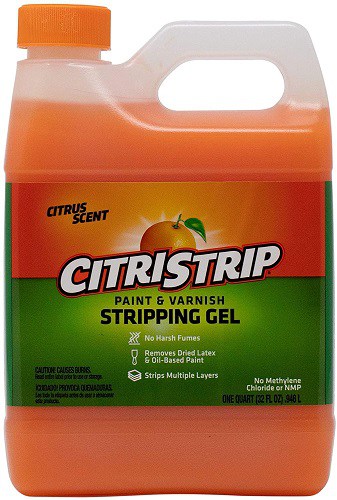
Citristrip QCSG801 Paint and Varnish Stripping Gel is the best paint stripper for wood. It works a treat in stripping a variety of painted surfaces, giving you a great result.
This product has a citrus smell, instead of a chemical one, making many people feel happy and safe to use it. But if you prefer an odorless product, this is still a good choice as it’s not too intense.
With a yogurt-like gel texture, Citristrip QCSG801 Paint and Varnish Stripping Gel works perfectly for 24 hours, which means it’ll work nonstop and go into the underlying paint to get rid of thick coats.
This product can be the perfect paint stripper for wood, metal, and masonry because it works perfectly on these materials.
When you use Citristrip QCSG801 Paint and Varnish Stripping Gel indoors, be sure to increase ventilation as this product will release fumes that can be harmful to health in an unaired room.
Wear some butyl gloves for your own safety as standard latex gloves may not protect your skin when using this paint remover.
Best for Concrete: Max Strip All-Purpose Remover
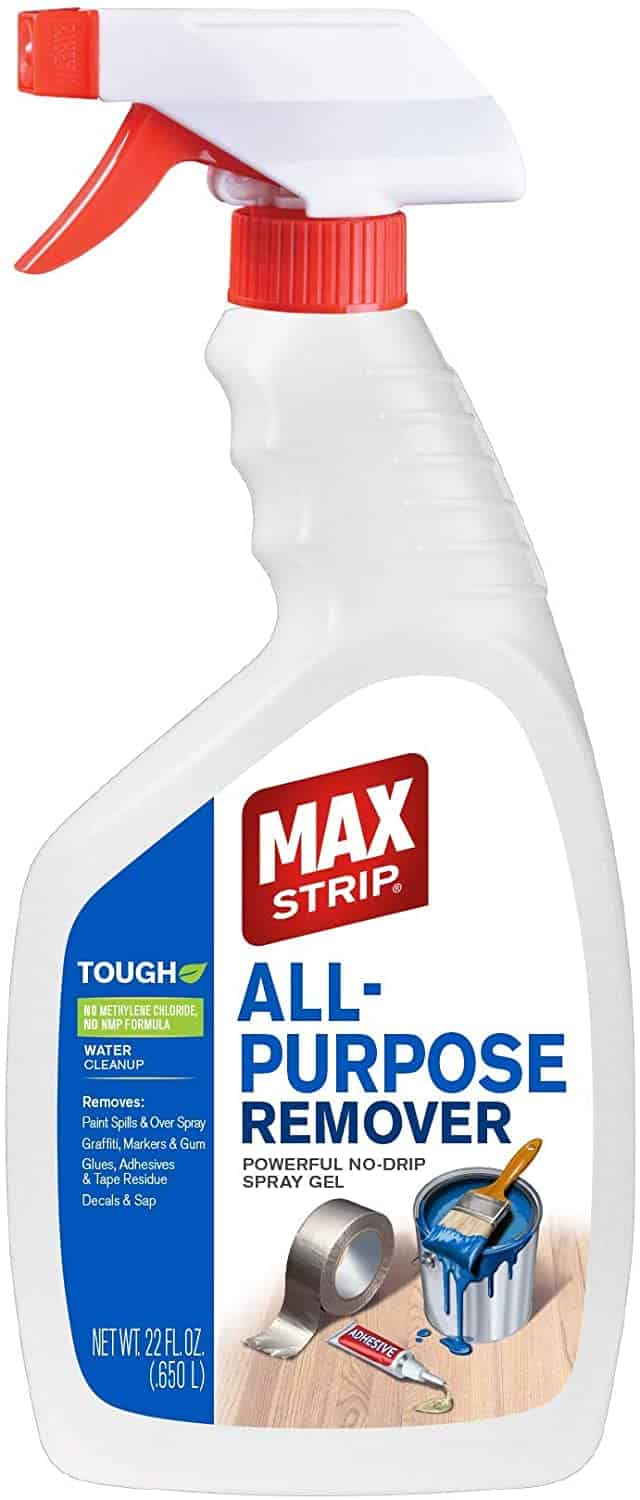
If you have sticky and tough stains on different surfaces at home, fear not! MAX Strip All-Purpose Paint Remover will take care of the problem.
It can handle tough tasks like removing old, stubborn paints on your concrete floors and walls. It also helps remove paint drips on your wooden surfaces, grime and grease, spills, and all sorts of horrid messes on surfaces.
As it’s a multipurpose remover, it can be relied on to clean up varnishes, paints, and stubborn stains from fiberglass, wood, porcelain, laminate, tile, stone, upholstery, and lots more. With this product, it’s never been easier to make your home cleaner and more inviting.
Many homeowners love how MAX Strip All-Purpose Paint Remover does the job of various products at the same time. For this reason, you can save some cash while cleaning up your outdoor and indoor space.
Buyer’s Guide for Choosing the Best Paint Stripper
Not all paint removers are suitable for all sorts of paint and surfaces. Some products have harsh chemicals that’ll require you to follow certain safety precautions. But using paint strippers comes with several benefits, especially if your project is a challenging one and you don’t have much time to complete it.
Advantages of Paint Strippers
- Some paint stripper varieties can work as fast as within 10 minutes, allowing you to quickly handle even the most difficult furniture projects.
- It’s much faster and easier to strip paint with a chemical stripper than with heat or steam.
- Paint strippers are a more affordable way to remove paint than using a costly heat gun, pressure washer, or sander.
- Since paint strippers are very easy to use, beginners would have no problem using them without experience.
- Solvents work effectively even on vertical types of surfaces and won’t make a mess or drip.
- Eco-friendly paint strippers are available on the market and can be perfect for eco-conscious buyers as they’re very friendly to the environment.
Using a paint remover comes with many benefits, especially if you’re strapped for cash or are a beginner. Now, we’ll take a look at the various types of paint strippers on the market and the factors to consider when buying them.
Types of Paint Removers
Paint strippers are available in four main varieties, each with special qualities that make them best suited for removing certain finishes from certain surfaces.
Some paint strippers are also better at removing polyurethane and epoxy, two long-lasting artificial coatings that are ever-present on surfaces like garage floors.
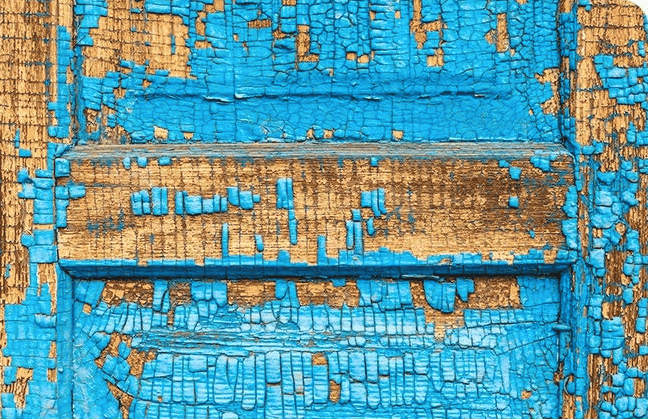
Solvent
Solvent paint strippers are the most versatile products and use chemicals to break the bond between surface and paint. They effectively strip oil and water-based paint, not to mention polyurethane and epoxy from wood, metal, and masonry surfaces without discoloration.
Although some solvent strippers contain methylene chloride, which contains a high amount of volatile organic compounds (VOC), others have a combination of methanol, alcohol, and toluene. While methylene chloride paint strippers are effective, they pose more severe health hazards than caustic paint strippers.
Caustic Paint Strippers
Caustic paint strippers contain a lye active ingredient i.e. sodium hydroxide, and partially turn dried paint to soap, loosening it from the surface. These paint removers aren’t suitable on polyurethane and epoxy; they’re ideal for getting rid of oil-based paints on masonry surfaces like brick fireplace areas and concrete floors.
While they also can remove oil and water-based paint from wood and some metals, caustic removers can erode materials like aluminum and black hardwoods like maple (you can remove this darkness with wood bleach).
Keep in mind that while caustic paint removers can irritate the lungs, skin, and eyes if inhaled or touched (making a respirator, skin-covering clothing, chemical-resistant gloves, and safety glasses necessary when using them), they’re lower in volatile organic compounds and safer than solvent removers.
Biochemical
These are safer alternatives to caustic and solvent strippers and are normally made with a mix of the organic compound NMP (N-methyl-2-pyrrolidone) and a plant-based solvent such as terpenes (which is found in citrus fruit rind and pine trees).
While lower in fumes and (VOC) volatile organic compounds, N-methyl-2-pyrrolidone can still abrade the skin and severely affect the reproductive and respiratory systems, so you should wear a respirator, skin-covering clothes, and chemical-resistant gloves when using it.
Biochemical paint removers can remove oil and water-based paint from wood, metal, and masonry surfaces, but they aren’t effective at removing polyurethane and epoxy coatings and may leave loose fibers of wood on the stripped wood surface.
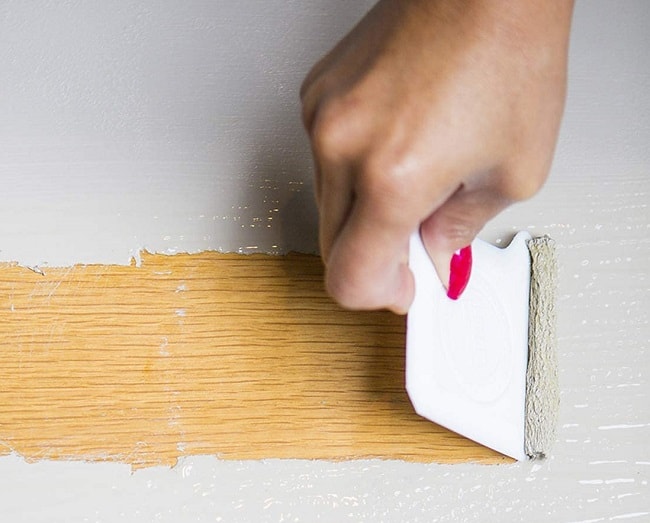
Zero-VOC
If the paint strippers listed above cause you to worry, consider using Zero-VOC paint strippers that are made without N-methyl-2-pyrrolidone, methylene chloride, or lye.
While they’re pricier, these products are almost odorless and are made from natural solvents such as benzyl alcohol that disintegrates the resins of oil and water-based paint to remove it from masonry, metal, and wood to some extent. They’re ineffective at removing polyurethane and epoxy, though.
While Zero-VOC paint strippers are the safest option on the market, direct exposure is still likely to redden the skin or irritate the lungs, so safety gloves and a respirator are also recommended.
Other Factors to Consider
Apart from the kind of paint stripper you intend to buy, you’ll also need to consider other factors, which we’ll discuss below.
Safety
Health safety is a vital factor you need to consider when buying a paint stripper. As paint strippers contain chemical compounds, they’re a potentially serious health hazard.
To stay safe health-wise, you should first equip yourself with protective gear and equipment. Gloves, masks, and protective glasses are essential.
Also, take into account the kind of paint strippers you use when buying gloves. Certain strong chemicals may corrode some common glove varieties like silicone, latex, etc.
Then, carefully read the manufacturer’s instructions. Some types of paint removers have special requirements like the need for dilution, high ventilation, 24-hour working time, etc. Be sure to do as they say!
Surface and Materials
When buying a paint stripper, find out which one is the best for wood, metal, masonry, and even plastic. Learn more about each paint stripper to find the best one for your surface and materials.
Think about the surface of whatever material you want to peel the paint off. The best paint remover for concrete might not be the right remover for brick or plastic or wood.
If you buy a paint remover that doesn’t suit your material, two things might happen. One, your remover may not be able to strip paint from the material. Two, the paint’s chemical ingredients may be so strong that it damages the material you’re stripping paint off.
As such, carefully consider the materials you’ll remove paint from to ensure you buy the right paint stripper and don’t waste money.
Paint Thickness
Some paint strippers are suitable for thick paint layers while others aren’t. If you lucky enough to pick the right paint, good for you! But if you buy a stripper that’s too weak to remove a thick layer of paint, you’ll end up spending more time scraping it off.
Volume
Are you buying a paint remover that’ll handle more than one job, or do you simply need a product that’ll work on an old furniture item you’ve been planning to repaint for ages?
Paint strippers come in many different volumes, so you could buy just enough to work on one furniture item or buy more for your other do-it-yourself projects.
Before buying, consider the container’s size and decide whether it’s better to buy a larger container so you’re always ready for another project in the future. Of course, if you have nowhere to store it, then it’s better to buy a small single-use can.
Extra Supplies Required
Before buying a paint remover, you must consider the extra cost of buying a pair of gloves, respirator, paint scrapper, and protective clothing. If you don’t have the budget for a respirator, you can rent one. Even if you have a respirator, you should always use a paint stripper in a well-aerated area.
Price
The good news is that most paint strippers are affordable, and a little amount can make a difference. Investing in a paint remover is much more affordable than buying a heat gun, steamer, or sander.
So if money is tight, a paint stripper may be the most cost-effective option if you need to repaint or refinish your old furniture.
FAQs On How to Find the Best Paint Stripper
Answer: The best paint strippers include:
• The Fastest Acting: Sunnyside 2-Minute Advanced Gel Remover;
• The Eco-Friendliest Option: Dumond Michaels Smart Strip Advanced Remover;
• The Most Heavy-Duty: Dumond Michaels Heavy-duty Peel Away 1 Paint Remover;
• The Most Family-friendly Option: MAX Strip Paint and Varnish Stripper;
• Best Overall: CitriStrip Paint and Varnish Removing Gel.
Answer: The easiest way to strip paint is to soften the paint with vegetable oil and then scrape off drips with a putty plastic knife. For tougher stains, try denatured alcohol or nail polish remover, but first try a small area to ensure the solvent doesn’t destroy the plastic. Then clean off solvent drops with warm water and dish soap.
Answer: The best tool for removing paint from wood is a plastic scraper. Scrape the paint off with the scraper and use mineral spirits and an abrasive pad to get rid of any remaining residue.
Answer: The answer is yes! Vinegar is an easy, effective and inexpensive way to remove stuck-on, dried paint from various surfaces, including wood. Above all, it gets rid of stubborn paint without producing any toxic fumes and harmful chemicals in the process.
Find the Best Paint Stripper Today!
As you can clearly see, you just can’t use any kind of paint stripper. Instead, your choice of stripper should depend on the kind of paint you want to remove and the type of surface.
Some paint removers work better than others, so make sure to figure out what kind of paint you want to remove, whether you must neutralize the paint stripper, and how long the paint stripper should stay on the surface prior to scraping.
It’s our hope that you’ll pick the right paint remover—one that’s not only powerful and effective but also affordable.
Further read:

